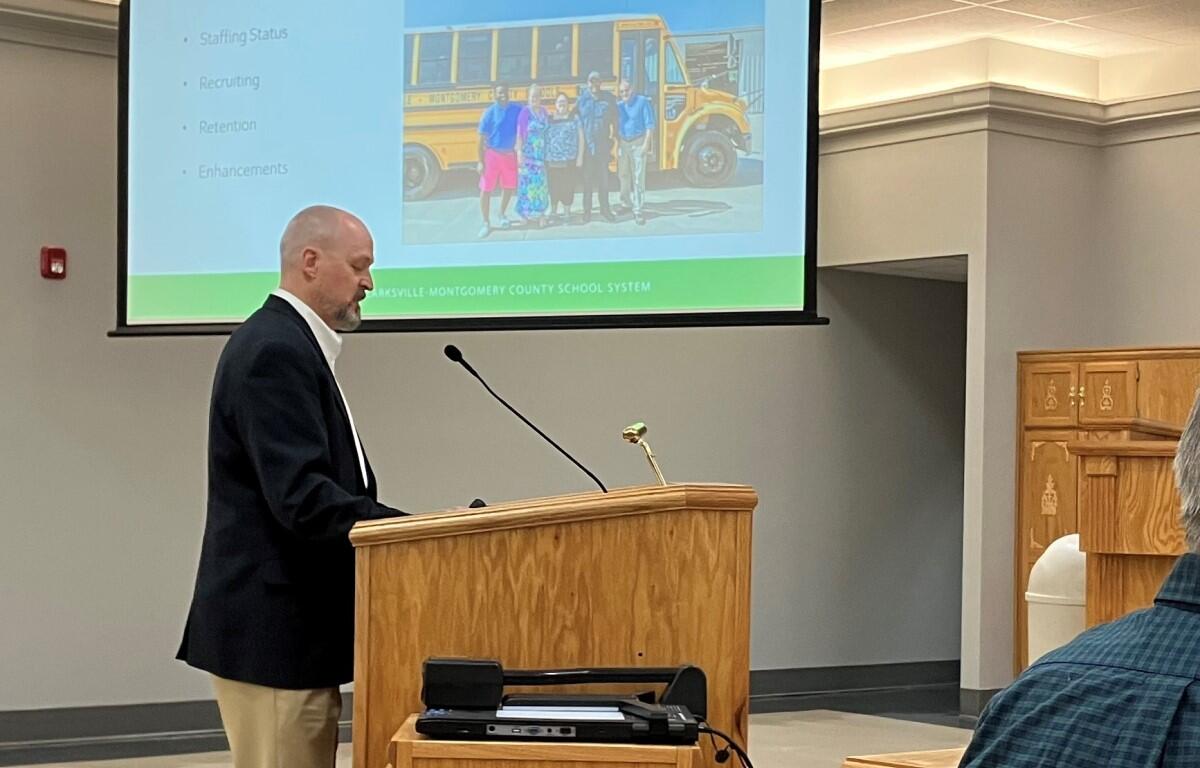CLARKSVILLE, TN (CLARKSVILLE NOW) – Amid an ongoing national shortage of school bus drivers, the Clarksville-Montgomery County School System has gone from crisis to coasting in just one year.
This time a year ago, CMCSS had 26 open bus routes and a major shortage of drivers, with a constant churn of resignations because of low pay and student behavior problems.
Today, CMCSS has 230 drivers covering 243 bus routes. That leaves 13 open routes open, which is half the number CMCSS was contending with last year, Operations Director Norm Brumblay told the School Board at Tuesday night’s meeting. Plus, 12 more drivers are in training to begin their routes in the next few weeks, and 3 new hires are pending background checks.
Having every route fully staffed is the goal. “We’re not there yet, but we do have reason to be excited,” Brumblay said.
“We can feel the difference now. Last year we were at 54% staffing. We almost had a 50% deficit. This August when we started school, we were a little bit better; we were at 59% staffing. But last month we were at 71% staffing,” he said.

In recruiting, he said, “the first half of this year has already exceeded our entire recruiting effort for the entire year for the past three years.”
Getting there took a strategic focus on two big problems: Driver pay and student behavior.
Driver pay, training
“Our first priority was pay, and you took care of that last year,” Brumblay told the board, referring to the board raising driver pay from $16.27 an hour to over $19.59 an hour, while also moving them from five hours per day to six hours per day.
Those changes have made local pay competitive with the hiring market. CMCSS has also added a variety of bonuses (such as a $1,000 sign-on bonus) and ways for drivers to work additional hours, if they wish.
The system also improved recruitment through creating a paid-driver training program. The new program condenses the time it takes to earn the required commercial driving license (CDL), and pays the trainees $10 an hour so they can make money while preparing to join the team. And during that program, the trainees serve as aides on the routes that they will run, helping them get to know the students and learn student management skills to address behavior issues.
Student behavior
The second major problem for retention has been drivers quitting because of student behavior. Of the drivers who resigned last year, 16% did so because of stress from student behavior on the buses.
The Operations Department took a systematic approach to addressing the issue, starting with moving resources to create a student safety and discipline coordinator. That person monitors bus conduct reports and looks for trends that can help the drivers and administrators, including identifying repeat offenders.
They then put over 3,000 student disciplinary reports into a database for analysis. They found discrepancies in practices, enforcement, and in how discipline referrals were handled.
They also found the repeat offenders: 97 students were causing one-third of the bus problems. “0.2% of our total school population was causing a third of the stress on our drivers,” Brumblay said.
CMCSS student behavior officials worked with those students to address the issues, bus drivers were given additional training in how to de-escalate and respond to problems, and more teacher monitors were added to routes.
As a result, Brumblay said, “We haven’t lost a driver for behavior this year.”
Ongoing temporary solutions
While many other districts in Tennessee will simply cancel a bus when a driver isn’t available, CMCSS will never tell a family that a bus is not coming, Brumblay said. All routes get covered through a variety of solutions.
One of those solutions has been double-runs, where a bus will go back out to do a second route, and there are 48 of those in use now, he said.
CMCSS also has 9 substitute drivers, 26 office staff and 13 mechanics who are certified to drive in a pinch. “This is how we keep our buses rolling. There may be delays, but we will not cancel,” Brumblay said.
The goal now, he said is to fill the 13 open routes as quickly as possible, hire enough drivers to eliminate the double runs, and then hire 10 additional substitute drivers to give CMCSS the flexibility to cover temporary openings.


